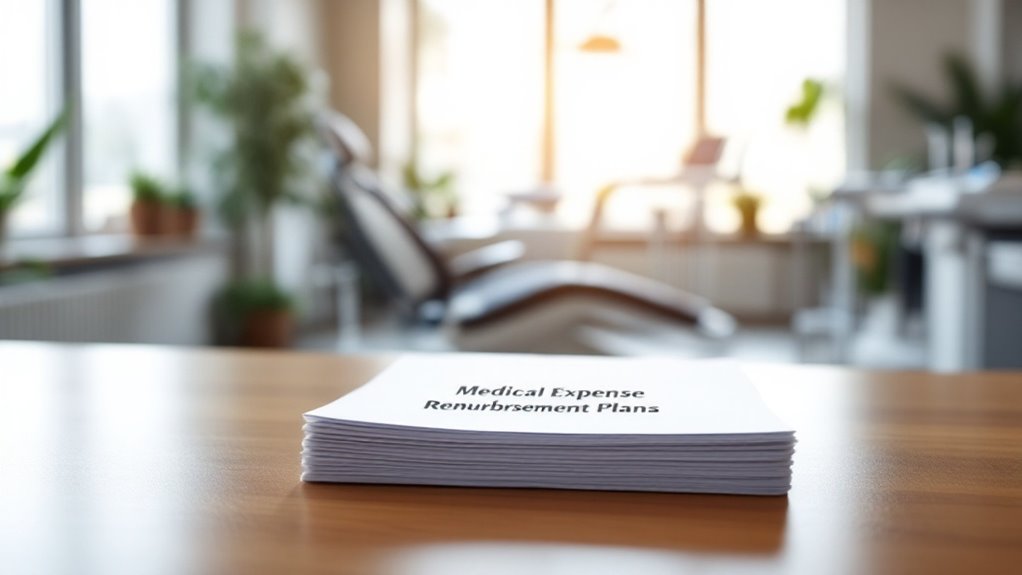You might think tax deductions are only for big corporations, but even dental practices can benefit greatly from a few strategic moves. By understanding the nuances of deductions available to you, you can save more money and reinvest it into your practice. For instance, have you considered how your equipment purchases could impact your tax bill? There are several approaches that can help you maximize your returns. Let us explore the key strategies that could make a real difference for your bottom line.
Key Takeaways
- Utilize Section 179 and bonus depreciation to deduct equipment costs fully in the year of purchase for significant tax savings.
- Deduct office expenses like rent and utilities, including a portion of home office expenses for home-based practices.
- Maintain accurate record-keeping of all expenses, including invoices and payroll, to maximize eligible tax deductions and simplify audits.
- Implement employee benefit plans such as SEP IRAs and MERPs, offering tax advantages while enhancing employee satisfaction and retention.
- Use expense tracking tools to automate documentation, categorize expenses, and ensure all deductible costs are accurately captured.
Maximizing Equipment Depreciation
When you're looking to maximize equipment depreciation for your dental practice, understanding the various methods available can make a significant difference in your tax savings.
You've got options like Section 179, allowing you to deduct the full price of qualifying equipment, or MACRS for faster recovery.
Accelerated depreciation offers immediate relief by expensing more in the early years, while straight-line depreciation spreads costs evenly. Upfront depreciation allows for a significant tax deduction in the year the equipment is purchased, which can be particularly beneficial for new acquisitions.
Bonus depreciation, introduced by the Tax Cuts and Jobs Act, lets you claim 100% in the year your equipment's placed in service.
Each of these depreciation strategies has unique tax implications, so keep detailed records and consult a dental CPA to guarantee you're making the most of your deductions and optimizing cash flow.
Retirement Plan Contributions
Retirement plan contributions play a crucial role in securing your financial future as a dental practice owner. By implementing SEP IRA strategies, you can enjoy low administrative costs and flexible contributions, making it easier to adjust based on your practice's financial health. Consider the SIMPLE IRA benefits, which allow employer matching and contributions to employees who meet specific eligibility criteria. If you want to provide robust retirement savings, a 401(k) plan offers customizable options and matching contributions that can enhance employee satisfaction. Higher participation rates lead to better overall retirement readiness when employees engage with retirement plans. For those looking to save aggressively, Defined Benefit plans can deliver predictable income streams, although they require more complex planning. Overall, these retirement plans offer essential retirement planning flexibility to meet your and your employees' needs.
Choosing the Right Practice Structure
As a dental practice owner, selecting the right practice structure is a key decision that can considerably impact your tax obligations and liability exposure.
You have several options, each with distinct tax implications and levels of liability protection. A sole proprietorship is simple but offers zero liability protection. Partnerships also lack this protection, though they allow for shared profits and losses. Limited Liability Companies (LLCs) provide flexibility and essential liability protection, making them popular. S Corporations pass income through to shareholders, reducing employment taxes while maintaining protection. Ultimately, C Corporations face double taxation and are less common among dental practices.
The sale taxation varies by business structure, so it's crucial to understand how your choice will affect your overall tax liability. Weigh these factors carefully to choose the structure that best suits your financial and legal needs.
Deducting Office Expenses
When it comes to deducting office expenses, you can markedly reduce your taxable income with smart strategies. Rent and utility costs, along with vital office supplies, are all eligible for deduction, so keeping track of these expenses is essential. By taking advantage of business-related deductions, you can further enhance your financial efficiency.
Rent and Utilities Deductions
Understanding the tax deductions available for rent and utilities can greatly impact your dental practice's bottom line.
If you rent office space, the full amount is deductible, which can substantially reduce your taxable income. Additionally, salaries paid to employees are also eligible for tax write-offs, further enhancing your practice's ability to manage expenses.
For home-based practices, you can claim a portion of your rent and utility bills as home office expenses, provided the space is used exclusively for business.
Keep accurate records of your rent payments and utility usage, as documentation is essential for any deductions you wish to claim.
Remember, only the portion of your utility bills that pertains to business operations is deductible, so you'll need to track this carefully.
Consulting a tax professional can help you navigate these deductions efficiently.
Office Supplies Write-Offs
Office supplies can account for a significant portion of your dental practice's expenses, making it crucial to know how to maximize your write-offs. Start by understanding what qualifies as deductible: dental tools, stationery, cleaning supplies, office furniture, and technology accessories. For effective office supply budgeting, track your expenses meticulously—this guarantees that you only claim what you've genuinely used for business. Remember, to qualify, supplies must be used at least 50% for business and purchased within the current tax year. Additionally, utilizing the Section 179 tax deduction can help you offset the costs of larger qualifying purchases made for your practice. Keep detailed records to support your claims and consult a tax advisor to verify eligibility.
Medical Expense Reimbursement Plans

Medical Expense Reimbursement Plans (MERPs) are often an overlooked yet influential tool for dental practices looking to optimize their tax strategies.
The MERP advantages are clear: they allow you to reimburse employees for medical expenses tax-free, creating financial relief for them while being tax-deductible for your practice. This setup not only promotes employee engagement but also encourages a healthier workforce. Additionally, MERPs provide tax-free reimbursements for employees and their dependents when properly administered.
By offering customizable plans, you can cater to your team's specific needs, thereby reducing complaints about healthcare costs. Plus, with a plan administrator handling claims, you'll face fewer administrative burdens.
Ultimately, MERPs provide a cost-effective solution that benefits both you and your employees, ensuring everyone is more engaged and satisfied with their healthcare options.
Utilizing Education Savings Accounts
While many dental practices focus primarily on immediate tax deductions, utilizing Education Savings Accounts (ESAs) can offer a strategic advantage for both owners and employees.
By investing in these tax-advantaged plans, you can enhance education funding for your employees' children while enjoying significant tax benefits. Options like 529 plans and Registered Education Savings Plans (RESPs) allow contributions to grow tax-free, and withdrawals for qualified education expenses are generally tax-free as well. Additionally, health savings account contributions are also tax-deductible, providing another avenue for financial benefits. The federal government even incentivizes saving through grants, making these accounts more appealing. As you promote college savings for your team, you create a supportive workplace culture, encouraging loyalty and motivation.
Embracing ESAs not only benefits your practice's finances but also strengthens your employees' futures.
Implementing Employee Benefit Plans

When you implement employee benefit plans, you're not just enhancing your team's well-being; you're also positioning your dental practice for long-term success. Offering extensive benefits like health insurance and retirement plans boosts employee wellness and satisfaction, making your practice more attractive to top talent. Communicating these benefits effectively is key—employees need to understand what you're offering and how it impacts their lives. Consider plans like HSAs to promote savings and health, and don't overlook the value of group-term life insurance and profit-sharing options. These strategies not only help with retention but can also provide significant tax advantages. Additionally, retirement plan options such as a SEP IRA can simplify administration while providing tax-deferred investment opportunities for your staff.
Documenting Deductions Effectively
To maximize your deductions, you need to maintain accurate records of all your expenses. Using expense tracking tools can streamline this process, making it easier to categorize and access your financial data when tax season rolls around. With organized documentation, you'll not only simplify your life but also guarantee you're taking full advantage of every deduction available to your dental practice. Additionally, keeping accurate records is essential for IRS compliance when hiring family members, as it helps justify their employment and compensation.
Maintain Accurate Records
Accurate record-keeping is essential for maximizing tax deductions in dental practices. You need to maintain thorough documentation, including detailed invoices and receipts for all purchases, payroll records, and continuing education expenses.
Consistent record organization helps you track every dollar, making the tax filing process smoother. Regularly updating these records guarantees you're ready for any financial audits, preventing eleventh-hour scrambles when deadlines approach. Properly documented expenses provide evidence during tax audits, further emphasizing the importance of maintaining accurate records.
Remember to document all eligible deductions thoroughly to meet compliance requirements. By keeping organized financial records, you can effortlessly demonstrate your practice's financial health while claiming the deductions you deserve.
Utilize Expense Tracking Tools
Maintaining precise records sets the stage for effectively utilizing expense tracking tools in your dental practice.
By leveraging expense software like Wave or FreshBooks, you can automate expense tracking, reducing manual errors and saving time. Additionally, AI-powered bookkeeping in tools like ReInvestWealth can further enhance automation, ensuring greater accuracy in your financial records.
Categorizing expenses simplifies identifying deductions, especially for recurring costs like supplies and utilities.
Implementing a digital receipt management system guarantees all documentation is readily available for financial audits.
Document each expense itemized with vendor information for clarity and accuracy.
Additionally, use tags to streamline transaction identification.
Regular audits help verify that everything's accounted for, keeping your finances in check.
With these tools, you'll not only enhance efficiency but also gain valuable insights into your practice's financial health.
Frequently Asked Questions
How Do I Calculate Depreciation for My Dental Equipment?
To calculate depreciation for your dental equipment, choose a method based on its lifespan. Straight-line spreads costs evenly, while accelerated methods deduct more upfront, offering different tax benefits depending on your practice's financial needs.
Can I Deduct Continuing Education Expenses for My Staff?
Did you know that companies investing in staff training see a 24% higher profit margin? You can deduct continuing education expenses through expense reimbursement, enhancing employee skills while reducing your practice's taxable income.
What Records Do I Need for Office Expense Deductions?
For office expense deductions, you'll need to keep office supply receipts and utilize expense tracking software. This guarantees accurate record-keeping, making it easier to substantiate your deductions come tax time. Stay organized!
Are There Tax Credits Available for Dental Practices?
Yes, there are tax credits available for dental practices. You can take advantage of tax incentives like the R&D Tax Credit or Child Tax Credit, which can enhance your financial health and offset dental reimbursements.
How Does the Choice of State Affect My Tax Deductions?
When it comes to tax deductions, you can't judge a book by its cover. Your state influences specific deductions and tax regulations, so knowing the rules can save you a bundle come tax season.
Conclusion
By implementing these tax deduction strategies, you can turn your dental practice into a financial powerhouse. Envision slashing your tax bill like a dentist with a precision drill—sharp and effective! Don't leave money on the table; take full advantage of equipment depreciation, retirement contributions, and all those office expenses. With the right approach, you'll not only boost your bottom line but also create a thriving practice that stands out. Start maximizing your deductions today!


